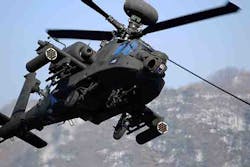U.S. Army Seeks New Helicopter Engine Designs from ATEC, GE
The U.S. Army awarded two contracts for new turboshaft engines designs to improve the performance and the affordability of engines powering its fleet of Black Hawk and Apache helicopters. One award, for a reported $154 million, went to the Advanced Turbine Engine Company (ATEC), a joint venture of Honeywell and Pratt & Whitney; the other, for a reported $102 million, went to GE Aviation.
The two-year contracts are part of a “preliminary design review” for a replacement engine design that the Army plans to select in 2018. At that time, the Improved Turbine Engine (ITE) program will proceed into the engineering and manufacturing development stage.
The UH-60 Black Hawk helicopter is a Sikorsky-designed, twin-engine utility helicopter. The AH-64 is a Boeing-designed, twin-engine attack helicopter, and both have been in production for over 40 years. Current models of both aircraft are powered by twin General Electric T700 turboshaft engines.
In addition to service with the U.S. Army, both helicopters are widely used by other Allied defense forces.
The Army’s objective is to replace the GE T700 engines powering an estimated 3,000 UH-60 Black Hawk and AH-64 Apache helicopters with a more powerful and fuel-efficient design. It has specified that the new engines should be 50% more powerful, 25% more fuel efficient, and provide 20% longer performance life than the current engines, while also meeting stringent performance goals for high altitude (6,000 feet) and high heat (95°F/35°C.)
The Army projects the total preliminary development cost at $720 million.
ATEC is developing an advanced 3,000-shaft horsepower turbine engine called the HPW3000. The venture stated it recently completed testing of two HPW3000 demonstrator engines, which performed very well and have already validated various program requirements, according to Craig Madden, president of ATEC.
GE Aviation’s research program is centered on its GE3000, also a 3,000-shaft horsepower design that GE noted would fulfill the specified performance goals and provide advanced turboshaft propulsion capability for the Black Hawk and Apache copters.
In addition, GE said derivatives of the engine would power versions of the Army’s Future Vertical Lift aircraft.
“The GE3000 integrates technologies demonstrated in two Army Science & Technology programs, the Advanced Affordable Turbine Engine (AATE) and the Future Affordable Turbine Engine (FATE), and includes additional technologies developed across GE’s military and commercial engine portfolio,” stated Harry Nahatis, general manager of GE Aviation’s Advanced Turboshaft/Turboprop projects.
About the Author
Robert Brooks
Content Director
Robert Brooks has been a business-to-business reporter, writer, editor, and columnist for more than 20 years, specializing in the primary metal and basic manufacturing industries.
